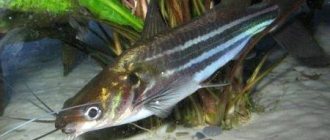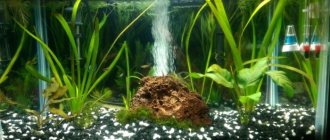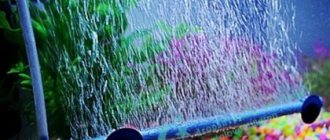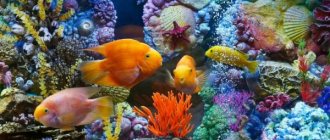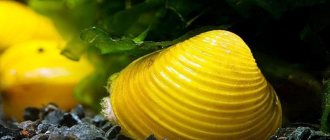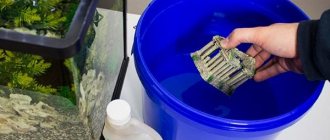The striped splasher fish (lat. Toxotes jaculatrix) can live in both fresh and brackish water. Muckers are very common in both Asia and northern Australia.
They primarily live in brackish mangrove swamps, where they spend their time standing with the current and looking for food. Singles can swim into the reef strip.
The species is distinguished by the fact that it has developed the ability to spit a thin stream of water at insects that sit on plants above the water.
The force of the impact is such that the insects fall into the water, where they are quickly eaten. The fish seem to have an unmistakable knowledge of where the prey will fall and quickly rush there before it is intercepted by others or carried away by the current.
In addition, they are able to jump out of the water to grab the victim, however, not high, to the length of the body. In addition to insects, they also eat small fish and a variety of larvae.
Habitat in nature
Toxotes jaculatrix was described by Peter Simon Pallas in 1767. Since then, the species name has changed several times (for example, Labrus jaculatrix or Sciaena jaculatrix).
Toxotes is a Greek word meaning archer. The word jaculatrix in English means "thrower". Both names directly indicate the main specificity of the spray fish.
The fish lives in Australia, the Philippines, Indonesia and the Solomon Islands. They mostly stay in brackish water (mangroves), although they can move upstream into fresh water or enter reef zones.
Common golden gourami (Trichogaster trichopterus - var.)
The common golden gourami is a bright, peaceful fish from the macropod family. It is a selective form of gourami, not found in the wild. All fish of the family are distinguished by the presence of a specific labyrinth organ that allows them to breathe atmospheric air. The golden gourami has a rich yellow coloration with vertical brownish stripes and contrasting specks on the fins. The fish grows up to 10-15 cm and can be recommended to beginners due to its unpretentiousness. A medium-sized aquarium is suitable for golden gourami. For decoration, it is better to use dark soil and natural plants - against their background the fish look luxurious.
Description
Splasher fish have excellent, binocular vision, which they need in order to hunt successfully. They spit with the help of a long and thin groove in the sky, and their long tongue covers it and serves as a bowstring.
The fish reaches 15 cm, although in nature it is almost twice as large. Moreover, they live in captivity for a long time, about 10 years.
The body color is bright silver or whitish, with 5-6 black vertical stripes-spots. The body is laterally compressed and rather elongated, with a pointed head.
There are also individuals with a yellow color throughout the body; they are much less common, but also more beautiful.
Appearance of a splashing fish
This perch-like species has large round eyes, flattened sides and a slightly protruding lower jaw.
In nature, an adult reaches up to 30 cm, in an aquarium - no more than 18 cm.
The color of the back of the splasher is greenish-steel or brown-steel, with wide transverse stripes of black. It is rare to see a yellow back.
There are 7 types of splashers. The most famous of them are spotted and striped. The spotted squirrel has a back with a small hump, and a more convex abdomen.
Difficulty in content
Extremely interesting fish to keep, and even if you put aside their unusual ability to spit water, they are still cool.
Recommended for experienced aquarists. In nature, this fish lives in both fresh and salt water, and is quite difficult to adapt to.
Banded splashers are difficult to feed as they instinctively seek food outside the tank, although over time they will begin to feed in a normal manner.
Another difficulty is that they jump out of the water in search of food. If you cover the aquarium, they will be injured; if you don’t cover them, they will jump out.
You need an open aquarium, but with a low enough water level so that they cannot jump out of it.
Splasher fish get along well with their neighbors, provided they are large enough in size. As a rule, they do not bother anyone if the neighbors are non-aggressive and do not bother them.
It is quite difficult to train them to hunt; they take a long time to get used to the aquarium and conditions, but if you succeed, then it is extremely fun to watch them hunt.
Just be careful not to overfeed the fish.
Compatibility
The sniper fish does not show aggression towards its relatives or other species. Feels comfortable in a flock of 4-6 individuals. The behavior is calm, but the reaction to stress factors is painful.
Best compatibility with aquarium species whose representatives have approximately the same body size as the splasher. The aquarium hunter perceives small fish as food.
Feeding
In nature, they feed on flies, spiders, mosquitoes and other insects, which are knocked off plants with a stream of water. They also eat fry, small fish and aquatic larvae.
In the aquarium they eat live food, fry and small fish. The most difficult thing is to accustom it to feeding in water; if the fish refuses to feed in the usual way, you can throw insects on the surface of the water, for example.
To stimulate the natural way of feeding, aquarists use various tricks, for example, releasing crickets above the surface of the water, flies, or gluing pieces of food.
With all this, it should be high enough, because if it is low, the fish will simply jump.
In general, if you are used to feeding in the water column or from the surface, then feeding them does not present any difficulty.
Keeping archer fish with other fish
Splashers are not aggressive fish, so they get along well with each other. A flock of shooters can be kept even in a fairly small aquarium. Splashers not only get along well with their fellow fish, but also get along with other species of fish. But neighbors should also be related to brackish-water rocks; for example, the silver monodactylus will be a good companion.
You can also add monodactylus and scatophagus to them. These exotic fish are not cheap, but the aquarium will look impressive, since these species are distinguished by unusual body shapes and a variety of colors.
Keeping in an aquarium
The minimum recommended volume for keeping spray guns is 200 liters. The greater the height of the aquarium between the surface of the water and the glass, the better, since they are excellent jumpers and can jump out of the aquarium.
An aquarium 50 cm high, two-thirds filled with water, is the absolute minimum for adult fish. They stay in the upper layer of water, constantly looking out for prey.
They are sensitive to the purity of water; they also need filtration and regular changes.
Water parameters: temperature 25-30C, pH: 7.0-8.0, 20 - 30 dGH.
In nature, they live in both fresh and brackish water. It is advisable to keep adult fish in water with a salinity of about 1.010. Juveniles live quietly in fresh water, although it is not uncommon for adult fish to live in fresh water for a long time.
As a decoration, it is better to use driftwood, in which the squirrels like to hide. The soil is not very important for them, but it is better to use sand or gravel.
To create an environment that most closely resembles their natural one, it is advisable to place plants above the surface of the water. You can plant insects on them that the fish will shoot down.
This is interesting
It is known that in humans a certain part of the brain is responsible for recognizing faces. Therefore, it has always been believed that such a skill is the prerogative of highly developed beings.
Experts from the Australian University of Queensland in Brisbane, led by Kate Newport, decided to check whether animals with a simpler brain structure really do not have this ability. squirt was selected for the study . Newport and his colleagues suggested that as well as developing the ability to shoot a stream of water, these fish may also have acquired the ability to recognize the outlines and shapes of objects, including human faces.
During the experiment, the fish were shown different photographs with people's faces. When they shot a stream of water at a specific photo, they received food. So the splashers had to remember which image to shoot at in order to receive a reward.
As a result, the fish were able to correctly identify faces in more than 80% of cases, despite the fact that their vision is not adapted for observing objects in the air and in the process of evolution they did not have such a need.
In addition, it turned out that splashers can remember about 40 different objects that they associate with food or the lack thereof.
Based on her results, Newport concluded that the possession of powerful cognitive abilities is not necessarily due to the need to recognize faces alone, which people living in human society cannot do without.
The study was published in the journal Scientific Reports.
Today, splashers can be seen in many public aquariums around the world. When kept in captivity, these fish often demonstrate their unique abilities, effortlessly knocking down various insects placed in the air space of aquariums.
Aplocheilus lineatus var. "Gold")
Aplocheilus lineatus aureus is a bright fish from the family of the same name. This is a breeding form of the common aplocheilus, which is naturally found in the waters of India. Aquarists call this fish “pike” for its similar appearance and habits: a swift, elongated body, a flattened wedge-shaped head, a slight curve in the middle of the body. The eyes of Aplocheilus are large and expressive. Fish often freeze in one place or swim slowly under the surface of the water, like a “predator in ambush.”
They are not aggressive, but they may accept smaller fish as food. The color of aplocheilus, as the name suggests, is bright golden. They grow about 10 cm. These fish are very unpretentious and can be recommended for beginners in a community aquarium with comparable neighbors.
How to cook red snapper
Like any other sea bass, it is fried in oil or grilled, stewed and baked. We fried red snapper in oil, breaded with flour and starch. The coating gives a crust and allows the fish to cook well inside. First, be sure to let the fish soak in the seasonings. You can serve fish with herbs and lime.
When cooking, you need to make several cuts in the carcass near the back. This part of the fish is the thickest and in order for the meat to cook evenly, it is necessary to equalize the sources of heat penetration inside. The Vietnamese use different spices when cooking - ginger, garlic, local Phu Quoc pepper, fish sauce. Grilled fish is especially delicious. 15-20 minutes are enough for the fish marinated in lime and oyster sauce to be ready to eat.
Epiplatys torch (Pseudepiplatys annulatus)
Epiplatis torch is a wonderful little fish for nano aquariums! Belongs to the Notobranchidae family. Another representative of African reservoirs. Epiplatis have a bright color: there are vertical cream stripes on the chocolate body, the iris and eyes are sky blue, and in the middle of the caudal fin there is an orange-red stripe reminiscent of a fire flame. Hence the name “torch”. These fish grow about 2-4 cm. They are absolutely harmless and like to stay in a school. Will fit perfectly into an aquarium from 20 liters. These little fish look great against the greenery!
Lures
When fishing in shallow water, snapper baits include a variety of spinning and fly baits used for fishing in various coastal fishing conditions and imitating various small inhabitants of reefs, mangroves and underwater marine thickets. In the case of fishing at great depths, it is possible to use jigs and other equipment for vertical lures. When using rigs for fishing with natural bait, you will need small live bait or cut fish, cephalopods or crustaceans.
Diseases and prevention
How long splashers live depends on the conditions of detention, but the fish’s immunity is quite strong, the average life expectancy is 6 years.
Fungal diseases occur most often. The reason is that it is kept only in fresh water. For prevention, the water must be salted.
Also, the condition of the fish worsens due to overfeeding. Nutrition should always be moderate.
The splashing fish is not a pet for beginner aquarists. In order for the fish to live a long time and remain healthy, it is important to maintain stable conditions, organize hunting, and properly equip the aquarium. In Asian countries, squirrels are used to entertain tourists; in our pet stores the price is 400-600 rubles per individual.
Source
Fishing methods
As with other snapper species, the most interesting snapper fishing is on spinning gear. It is absolutely certain that when fishing in mangroves or other places with moderate depths, an equally interesting method of fishing is fly fishing. With regard to spinning, taking into account the habitat, fishing can be done both “casting” and “plumb” using appropriate bait. Like most marine predators, snappers are voracious and indiscriminate in their choice of prey, so they can be caught using natural bait. To do this, you can use any suitable gear: from a regular piece of fishing line with a hook and sinker to special equipment for drifting.
Catching snappers with a spinning rod “casting”
When choosing gear for fishing with a classic spinning rod for catching snapper snappers, it is advisable to proceed from the principle: “the size of the trophy is the size of the bait.” In addition, the priority approach should be “onboard” or “shore fishing”. Sea vessels are more convenient for spinning fishing, but there may be limitations here too. For coastal specialized fishing for small snappers, “serious” sea gear is not required: when choosing gear, it is better to deviate from the size of the bait. Although it is worth noting that even small fish desperately resist, and this gives a lot of pleasure to anglers. Snappers often stay in various conditions of the coastal zone, and therefore, using spinning rods from sea watercraft, it is possible to fish with classic baits: spinners, wobblers, etc. Reels must have a good supply of fishing line or cord. In addition to a trouble-free braking system, the reel must be protected from salt water. Many types of sea fishing equipment require very fast retrieval, which means a high gear ratio of the reeling mechanism. According to the principle of operation, the coils can be either multiplier or inertia-free. Accordingly, rods are selected depending on the reel system. The choice of fishing rods is very diverse; at the moment, manufacturers offer a large number of specialized “forms” for various fishing conditions and types of bait. When fishing for sea fish with a spinning rod, fishing technique is very important. To select the correct wiring, you should consult with experienced fishermen or guides.
Catching snappers "in a plumb line"
In difficult conditions of deep-sea reefs, the most successful fishing for snappers can be considered vertical trolling or jigging. In this case, you can use various attachments, including natural ones. When fishing with this method at great depths, if caught, fishing will occur with a large load on the gear, so rods and reels, first of all, must be powerful enough. Cords with special markings to determine the length used are very convenient. When fishing with vertical lures, it is very important to make the correct retrieve to attract fish. As in the case of casting fishing, you should definitely check with experienced fishermen about the fishing technique.


